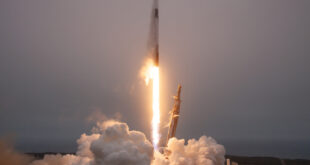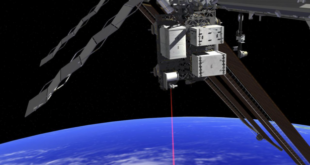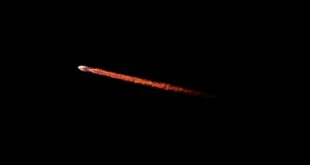By Alexey Shirobokov

The Earth has recently experienced a powerful geomagnetic storm, rated as G4 on a five-point scale. This storm, accompanied by the Sun’s most significant solar flare in two decades and a colossal plasma cloud hurtling towards us, is a stark reminder of our vulnerability to space weather. Its effects are expected to persist for at least another week, underscoring the importance of preparedness for future solar storms.
This phenomenon could disrupt numerous processes on Earth and in space, including critical infrastructure related to communications, television, GPS, aviation, and financial exchanges. However, by staying informed about space weather forecasts, we can empower ourselves to mitigate these potential disruptions. That is why it is essential to have a deeper understanding of the recent events, their possible consequences, and the importance of preparedness for future solar storms.
Current Events and Its Potential Impacts
The storm reached the Earth around May 10, 2024, and lingered for over a week, causing spectacular displays of aurora borealis worldwide. An X8.7 solar flare accompanied the storm, the most powerful of the current solar cycle, emanating from sunspot AR 3664 at 12.51 P.M. ET on May 14, 2024, spanning an impressive 16 times the diameter of Earth. For context, X-class denotes the most intense flare, one of the largest of the current 11-year cycle that was not anticipated to cause auroras so far south.
The Sun is nearing the peak of Solar Cycle 25, expected in 2025, suggesting a heightened likelihood of auroral activity in the years to come. Historical analysis indicates that “severe” G4 magnetic storms have occurred in 42 out of the last 150 years, with “great” G5 super-storms occurring in 6 out of those 150 years. However, it’s important to note that previous solar cycles were generally less active and resulted in minimal disruptions to critical infrastructure.
Affected Industries and Organizations
This solar flare posed a significant threat to technologies reliant on Earth’s ionosphere. While the extent of the disruptions remains unclear, it is evident that many entities encountered difficulties during the geomagnetic storm.
Potential breakdowns included the loss of high-frequency radio communication, which is crucial for navigation and GPS. At this intensity level, widespread blackouts of high-frequency radio communication were anticipated, along with a loss of radio contact for about an hour on the sunlit side of the Earth.
The recent geomagnetic storm is a wake-up call for humanity’s vulnerability to space weather.
Additionally, low-frequency navigation signals were expected to weaken for roughly an hour. Even more concerning is the potential impact of a G5 storm, which may make high-frequency radio transmission impossible in many locations for one or two days, damage satellite navigation, and disable low-frequency navigation for hours. In other words, this means that regular radios and satellite navigation systems would not work for quite a while.
The energy sector, transformer suppliers, and telecommunication operators were also potentially impacted. In particular, geomagnetic storms can induce currents within power grids, overloading transformers and potentially causing blackouts. This can sometimes lead to damaged equipment and the need to reroute power or switch transmission lines. These events incur significant financial losses, not to mention the costs associated with repairing damaged equipment.
As for telecommunication, fluctuations in the Earth’s magnetic field could hinder communication infrastructure and impact aviation safety and space travel. Also, a moderate solar radiation storm could expose aeroplane passengers on high-altitude flights to elevated radiation and occasionally disrupt satellite operations.
The National Oceanic and Atmospheric Administration (NOAA) of the United States already categorized the storm as “extreme” and documented disruptions to power grids, broadband technology, and GPS satellites. Similar consequences were observed during the G5 storm in 2003, which caused power outages in Sweden and damaged transformers in South Africa.
Likelihood of Similar Events
Predicting the likelihood of future G4 geomagnetic storms, which can significantly impact our technology-reliant society, proves challenging. There is no guarantee that future events will be stronger or weaker. Sunspot numbers are predicted with some accuracy; however, recent research suggests that Solar Cycle 25 could peak with a maximum sunspot number between approximately 210 and 260.
On the other hand, the Space Weather Prediction Panel has forecasted a maximum of 115 for July 2025. While the current cycle exceeds some predictions by 20%, this doesn’t necessarily indicate the severity of future storms. It highlights the relative nature of these statistical models based on past observations.
On a brighter note, advancements are being made in medium-term forecasting of solar events that could impact Earth, including geomagnetic storms. Techniques like helioseismology, which tracks the twisting of the Sun’s internal magnetic fields and measures the surface magnetic field strength, are employed to improve the accuracy of solar flare predictions by two or three days. These models, while not perfect, offer valuable lead time for preparation.
One significant hurdle to more accurate forecasting lies in our aging satellite infrastructure. For instance, L1 (Lagrange Point 1) satellites transmit the most important data practically near the Sun (1.5 million kilometres away from Earth) — they are the first frontier collecting space weather measurements. They are typically large and really expensive machines. The costs associated with these satellites include their construction, launch, and maintenance. On average, the development time for such satellites ranges from 10 to 15 years. However, many L1 satellites crucial for space weather monitoring operate beyond their designed lifespans, with only meteorological constellations receiving regular upgrades. Satellites’ vulnerability to solar flares further compounds these limitations. Disruptions from intense radiation can affect instruments like plasma density measurement devices, hindering our ability to understand the characteristics of solar storms fully.
The potential for data gaps due to aging satellites underscores the importance of regular maintenance and upgrades. However, it’s not enough. We need to invest in deploying secondary satellite systems, a crucial step that could significantly improve the quality and reliability of space weather data.
The Need for Second-Tier Satellites in Space Weather Monitoring
The answer lies in the potential catastrophic drop in the quality of space weather forecasting if the instruments of the first level (the first echelon, like the GOES-16) fail. While regular maintenance and upgrades are crucial for existing space weather monitoring infrastructure, the potential consequences of instrument failure warrant exploring additional solutions.
Secondary, or “second-tier,” satellite constellations offer a compelling solution. Mission Space, for example, demonstrates the feasibility of such a system. Their constellation utilizes Küpsats – lightweight satellites launched into low Earth orbit at a significantly lower cost than traditional magnetospheric satellites. This cost-effectiveness allows for quicker deployment and redundancy in the event of primary satellite failure.
It is essential to have a deeper understanding of the recent events.
The cost comparison between launching a traditional magnetospheric satellite and a Küpsat constellation is stark. Launching a magnetospheric satellite can be lengthy, taking 10-15 years and incurring significantly higher costs. In contrast, SpaceX offers launches for small satellites (50 kg) to sun-synchronous orbit for $275,000, with an additional fee per kilogram for the launch vehicle ($45,500 per kg for Falcon 9).
Are We Ready for the Next Solar Storm?
While our space weather monitoring infrastructure needs to be at total capacity, recent advancements promise improved preparedness. The recent NOAA Space Weather Prediction Center collaboration with other federal agencies signifies a positive step towards enhanced forecasting and mitigation strategies.
The issuance of a G4 storm watch, the first in nearly two decades, demonstrates significant progress in prediction capabilities. In the past, storms of this magnitude occurred, but the predictive capabilities were not as refined, often leaving critical infrastructure operators with little to no time to prepare for the incoming geomagnetic storm particles. However, this recent G4 storm watch provided a window of 20-45 minutes, a crucial period that allowed these operators to brace for the storm’s impact. This incident highlights the effectiveness of improved forecasting in facilitating preparedness.
So, it is indeed realistic to prepare for a G4 storm. The key is to stay informed about space weather forecasts and take necessary precautions when a severe geomagnetic storm watch is issued. Critical infrastructure operators should also have contingency plans to mitigate the potential impacts of such storms.
The recent G4 geomagnetic storm is a wake-up call for humanity’s vulnerability to space weather. While the immediate disruptions from the storm were only moderate, the potential for more severe consequences cannot be overlooked. These consequences may not be immediate, but rather a slow burn, with each storm chipping away at our infrastructure’s resilience. A seemingly minor event following this barrage could trigger cascading failures due to this cumulative effect. This highlights the urgent need for heightened preparedness, meaning regular infrastructure upgrades and exploration of redundant satellite constellations are crucial to ensure reliable space weather data collection.

Alexey Shirobokov serial tech entrepreneur, angel investor, and cofounder at Mission Space (a space weather data & analytic company based in Luxembourg). In 2010, Alexey received a master’s degree in economics. After working for more than 2 years in prestigious corporations, including Microsoft and Ernst&Young, in 2014 Alexey founded his first business, a consulting and IT-service company. Since then Alexey has cofounded 3 successful companies, including Mission Space. The company collects high-quality space weather data and develops the first private satellite-based space weather nowcast and forecast system as well as cloud services that enable both space and ground-based businesses to measure and mitigate the potential impacts of space storms. Mission Space is heavily involved in the space & scientific industrial communities and is a full member of the oldest and the most important space bodies International Astronautical Federation, and many other scientific and space industrial communities.
 SpaceWatch.Global An independent perspective on space
SpaceWatch.Global An independent perspective on space




